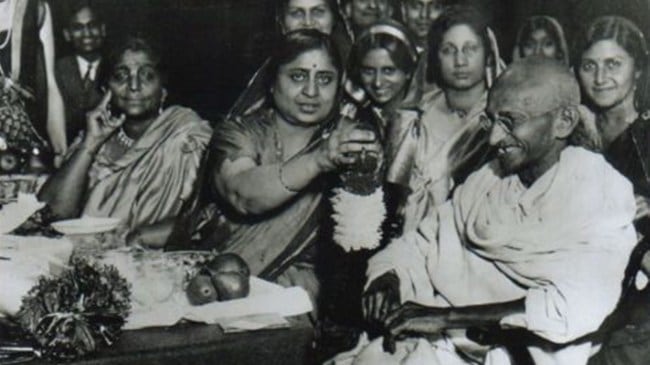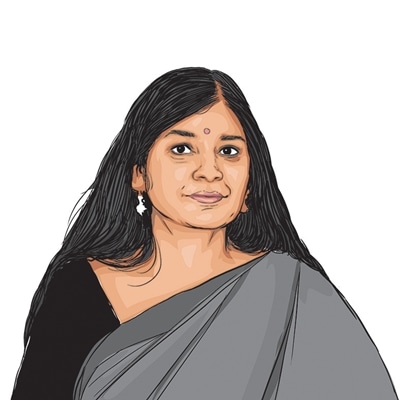Opinion What Mahatma Gandhi can teach us about gender equality
He saw women as equals in all spheres of life, encouraging political participation and leadership and tied the notions of ‘swaraj’ and ‘satyagraha’ to women’s development
 Mahatma Gandhi’s gendering of the political landscape challenged hypermasculine norms. (Wikimedia Commons)
Mahatma Gandhi’s gendering of the political landscape challenged hypermasculine norms. (Wikimedia Commons) This International Women’s Day, we strive to engage with a person, some of whose ideas have obscured his larger contribution and vision for women’s empowerment in India. Can we reclaim Mahatma Gandhi’s ideas on gender equality? His image has been constructed and reconstructed through significant political moments, commemoration of important days and a vast range of literature, even as a critical engagement with his ideas and perspectives continues.
Gandhi’s vision for women’s empowerment, articulated during the All India Women’s Conference in 1936, marked a paradigm shift in India’s struggle for freedom. We delve into the multifaceted aspects of Gandhi’s approach to women’s empowerment, examining the historical context, critiques, and the enduring impact of his philosophy on the challenges and opportunities faced by women in contemporary India. Unlike conventional reform movements, he positioned women as active agents, rather than passive recipients, fostering a collective consciousness essential for liberation. Gandhi envisioned a society where women, transitioning from “abla” (helpless) to “sabla” (empowered), would become powerful catalysts for change.
In contemporary times, despite progressive movements and important government initiatives to address issues like representation, domestic violence, reproductive autonomy and sexual harassment, challenges and stereotypes persist in society. The recent attention that the issue of gender equality has received in politics, health, education, and workforce participation calls for an engagement with, and reclamation of, Gandhi’s vision of women as “equals” in all spheres of life.
One of Gandhi’s most accepted contributions to the woman question is his assertion that the ideas of satyagraha and swaraj cannot be pursued without the active participation of women in the Indian freedom struggle. This brought women from the fringes into mainstream discourse and movements. Scholars like Bhikhu Parekh assert that it was Gandhi who transformed women from passive recipients to active agents during various phases of the freedom struggle.
On the other hand, critics argue that even though Gandhi challenged traditional roles, he retained essentialist constructions of masculinity and femininity. However, while using these essentialist arguments, Gandhi also appealed to men to learn from women. He said and proved that women could be the leaders of the non-violent struggle. Consequently, Gandhi had no difficulty in reconciling the representation of women as guardians of the home and hearth with the political reality, to which women such as Sarojini Naidu, Sucheta Kripalani, Usha Mehta and Aruna Asaf Ali gave vibrant expression.
While remaining alert to the limitations of his thoughts and philosophy about women’s empowerment, we formulate three theoretical frameworks, based on his principles and programmes, to reclaim him for “women-led” development today.
Gendering the political sphere
Gandhi’s gendering of the political landscape challenged hypermasculine norms. Satyagraha, swaraj, and swadeshi became potent tools for women’s political mobilisation. Gandhi’s expansive vision of swaraj included freedom from gender-based discrimination, economic independence, and political agency for women.
Gandhi’s mobilisation, which led to the mass involvement of women in the Indian national movement, was a radical process that challenged the traditional notions of leadership, resistance and power, steeped in hegemonic masculinity. One of the most significant arguments in Gandhi’s writings was a deeper analysis of colonialism’s adverse impact on women’s economic status in India. Therefore, he argued that an important component of swaraj was the idea of economic independence through self-reliance, which is impossible without including women.
Gendering the social
Gandhi equalised the social space by offering an intellectual critique of orthodox social customs and traditions that were oppressive to women during his public meetings. He especially spoke against female infanticide, dowry, sati and the purdah system, prevalent during these times, as constraints to the political liberation of women. By challenging prevailing norms, Gandhi paved the way for women to claim public spaces, democratising streets, temples, and organisations.
Gandhi was also able to strategise his mission for the social upliftment of women by alluding to texts, scriptures and folklore embedded into the social consciousness of the people of India. Gandhi gave voice and agency to the women of India by giving a voice to Sita. He changed the narrative and venerated the moral strength and resilience of Sita whose “truth force” (satyagraha) defeated Ravan’s brute masculinity, as an example for the women of India to resist social oppression and colonial powers. He also acknowledged how Mirabai defied patriarchal norms through her “act of satyagraha”.
Gendering the personal
Critics have debated Gandhi’s essentialist approach, associating women with specific attributes to fulfil political goals. However, Gandhi’s ideas have challenged hypermasculine power, breaking down binaries between masculinity and femininity.
In a critical examination of Gandhi’s strategies, members of the women’s movement have also alluded to the fact that many of Gandhi’s methods, were their methods or those that women employed in their personal sphere for protest, rebellion or bringing about change. Fasting as a way of protest, which Gandhi frequently did, reflects a strategy employed by women in their day-to-day negotiations in the domestic sphere. His embracing of the principles of non-violence and his engagement with the idea of salt or spinning of the charkha, symbolised women-centric ethics and practices.
The idea of power, imagined only in terms of physical prowess, is not a part of Gandhi’s discourse. His choice of clothing, his mannerisms, his personality, his language, revealed a vulnerability, associated with maternal attributes. A study of Gandhi, his dinacharya, reveals that he spent a large amount of time nurturing animals and taking care of cleanliness. His niece, Manu Gandhi’s book and its title Bapu — My Mother, is revealing.
Paradigm shifts in evaluating equality, development and progress are necessary. Gandhi provides a humane worldview. Following his example, we must learn to tap into ethical and spiritual forces. This will lead to a meaningful and creative existence for all. A consistent engagement with Gandhi’s principles provides valuable insights into how the evolving role of women in Indian society can be addressed and embraced . While remaining alert to his limitations in the context of gender equality, we must strive to capture “moments” from his ideas and practices and reformulate them for a vision of an egalitarian society.
Nanda is professor of Political Science and principal, Miranda House. Ray is an associate professor at the Department of Political Science, Kamala Nehru College, University of Delhi. They are co-editors of Discourse on Rights in India: Debates and Dilemmas






